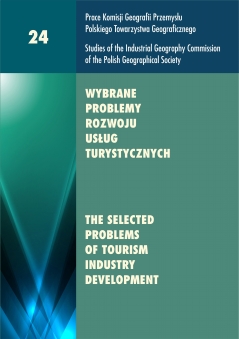Relation Between the Place in International Hierarchies of Cities and the Level of Tourist Services
DOI:
https://doi.org/10.24917/20801653.24.5Keywords:
business tourism, hierarchies of cities, tourist services, world citiesAbstract
This paper describes the level of development of tourism services and infrastructure, whichmay affect the international connections of cities. The study takes into account the number of nightsspent by foreign tourists, equipment of hotels, accommodation facilities in conference services andthe number of accommodation facilities and higher average category. The created ranking of Polishcities which are capitals of the provinces in terms of services and infrastructure is then compared to thehierarchy of global cities, and European cities. The last ranking also lists the level of socio-economicdevelopment of Polish cities. It is found that the Polish centers, which are characterized by the best-developedbase middle and upper class of accommodation places, and offer a wide range of servicesrelated to the organization of business meetings and conferences, are also classified in the highest internationalhierarchies. In addition, there is no direct relationship between the number of city inhabitantsand the number of foreign tourists visiting a city, or the level of development of tourist infrastructureand services these cities.Downloads
References
Bartoszewicz, W., Borne-Januła, H., Buczak, T., Skalska, T., Socjała J. (2003). Metodologia badań i badania pilotażowe turystyki biznesowej. Warszawa: Instytut Turystyki.
Beaverstock, J.V, Smith, R.G., Taylor, P.J. (1999). A Rooster of World Cities. Cities, 6(6), 445–458.
Bogdański, M. (2012). Socio-economic Potential of Polish Cities – a Regional Dimension. Bulletin of Geography Socio-economic Series, 17, 13–20.
Burger, J.M., Knaap B. van der, Wall, R.S. (2012). Revealed Competition for Greenfield Investment in European Regions. Journal of Economic Geography, published September 2012 (online).
METREX – European Metropolitan Regions and Areas (2000). www.eurometrex.org/EN/index.asp
ESPON Atlas. (2006). Mapping the Structure of the European Territory. Federal Office for Building and Regional Planning.
GAWC Research Data, http://www.lboro.ac.uk/gawc.
Główny Urząd Statystyczny, www.stat.gov.pl.
Gorzelak, G., Jałowiecki, B., Smętkowski, M. (red.). (2009). Obszary Metropolitalne w Polsce: proble¬my rozwojowe i delimitacja. Raporty i analizy EUROREG 1/2009, Warszawa.
Jakóbczyk-Gryszkiewicz, J. (2011). Łódź u progu XX wieku. Studia Miejskie, nr 4, Opole, 131–138.
Jałowiecki, B. (red.). (2006). Uwarunkowania i szanse rozwoju polskich metropolii. Warszawa: Departament Koordynacji Polityki Strukturalnej MGPiPS.
Krätke, S. (2007). Metropolisation of the European Economic Territory as a Consequence of Increasing Specialisation of Urban Agglomerations in the Knowledge Economy. European Planning Studies, 15, 1–27.
Kulbaczewska, M., Kubicki, R. (2007). Analiza ruchu turystycznego w zakładach uzdrowiskowych na tle obiektów noclegowych ogółem w województwie zachodniopomorskim w latach 2001–2005. Zeszyty Naukowe, 466, Uniwersytet Szczeciński.
Kulesza, I. (red.). (2008). Turystyka biznesowa w Polsce. Warszawa: Instytut Turystyki.
Kurek, S. (2010). Przestrzenne zróżnicowanie poziomu rozwoju regionalnego w Unii Europejskiej w świetle wybranych mierników. Prace Komisji Geografii Przemysłu Polskiego Towarzystwa Geograficznego, 16, 87–104.
Kłębek, K. (red.). (2009). Turystyka biznesowa w Polsce. Kraków: AWF.
Michalak, Z., Warzocha, J. (2007). Turystyka biznesowa jako produkt łagodzący skutki sezonowości w działalności hotelarskiej. Zeszyty Naukowe, 466, Uniwersytet Szczeciński.
Nowakowska, A. (2002). Turystyka, turysta, ruch turystyczny. W: G. Gołembski (red.). Kompedium wiedzy o turystyce. Warszawa–Poznań: PWN, 191–196.
Raźniak, P. (2012a). Procesy społeczno-ekonomiczne w Krakowskim Obszarze Metropolitalnym. Prace Geograficzne Uniwersytetu Jagiellońskiego, 129, 63–81.
Raźniak, P. (2012b). Global Connections of European Metropolises – an Attempt to Typology, Multikulturalis Muhely, 2, 102–108.
Raźniak, P. (2013). Globalne powiązania metropolii europejskich – próba typologii. Studia Miejskie, 9, 83–94.
Suliborski, A., Wójcik, M., Walkiewicz, D. (2010). Funkcje i struktura funkcjonalna Łódzkiego Obszaru Metropolitalnego. W: A. Jewtuchowicz, M. Wójcik (red.). Łódzka Metropolia – Problemy integracji gospodarczej, Łódź, 21–40.
Szymańska, A.I. (2012a). User-driven Innovation – a Consumer as a Source of Innovation in the Enterproise. W: K. Zawadzki (red.). Challenges for the SME Sector in the Twenty-first Century, Gdańsk, Politechnika Gdańska, Wydział Zarządzania i Ekonomii, 58–67.
Szymańska, A.I. (2012b). User-driven Innovation (UDI) – nowe podejście do innowacji a preferencje konsumentów. W: R. Pukała (red.). Zarządzanie podmiotami gospodarczymi i instytucja¬mi. Wybrane zagadnienia. Jarosław: Wydawnictwo Państwowej Wyższej Szkoły Techniczno- -Ekonomicznej im. ks. Bronisława Markiewicza w Jarosławiu, 9–31.
Szymańska, A.I. (2012c). Wpływ innowacyjności na konkurencyjność przedsiębiorstw. W: A. Stabryła, T. Małkus (red.). Strategie rozwoju organizacji, seria wydawnicza: Encyklopedia Zarządzania, Kraków, Mfiles.pl, 183–197.
Taylor, P.J., Hoyler, M., Sánchez-Moral, S. (2012). European Cities in Globalization: A Comparative Analysis Based on the Location Strategies of Advanced Producer Services. GAWC Research Bulletin, 416, http://www.lboro.ac.uk/gawc.
Taylor, P.J. (2012). The Challenge Fading World City Network Analysis. GaWC Research Bulletin, 409, http://www.lboro.ac.uk/gawc.
Taylor, P.J., Ni, P., Derudder, B., Hoyler, M., Huang, J., Lu, F., Pain, K., Witlox, F., Yang, X., Basens, D., Shen, W. (2010). Measuring the World City Network: New Results and Developments. GaWC Research Bulletin, 300, http://www.lboro.ac.uk/gawc.
Vijver, E. Van De, Derudder, B., Bassens, D., Witlox, F. (2012). Filling Some Black Holes: Modeling the Connection between Urbanization, Infrastructure, and Global Service Intensity. GAWC Research Bulletin, 396, http://www.lboro.ac.uk/gawc.
Winiarczyk-Raźniak, A., Raźniak, P. (2012). Migracje wewnętrzne ludności w polskich obszarach metropolitalnych u progu XXI wieku. Kraków: Wydawnictwo Naukowe UP.
Zdon-Korzeniowska, M., Rachwał, T. (2011). Turystyka w warunkach światowego kryzysu gospodarczego. Prace Komisji Geografii Przemysłu Polskiego Towarzystwa Geograficznego, 18, 116–128.
Zuzańska-Żyśko, E. (2012). Funkcje metropolitalne Górnośląskiego Obszaru Metropolitalnego. Studia Regionalne i Lokalne, 2(48), 39–61.
Downloads
Published
How to Cite
Issue
Section
License
Articles are published under the terms of the Creative Commons License (CC BY-ND 4.0; Attribution– NoDerivs).

